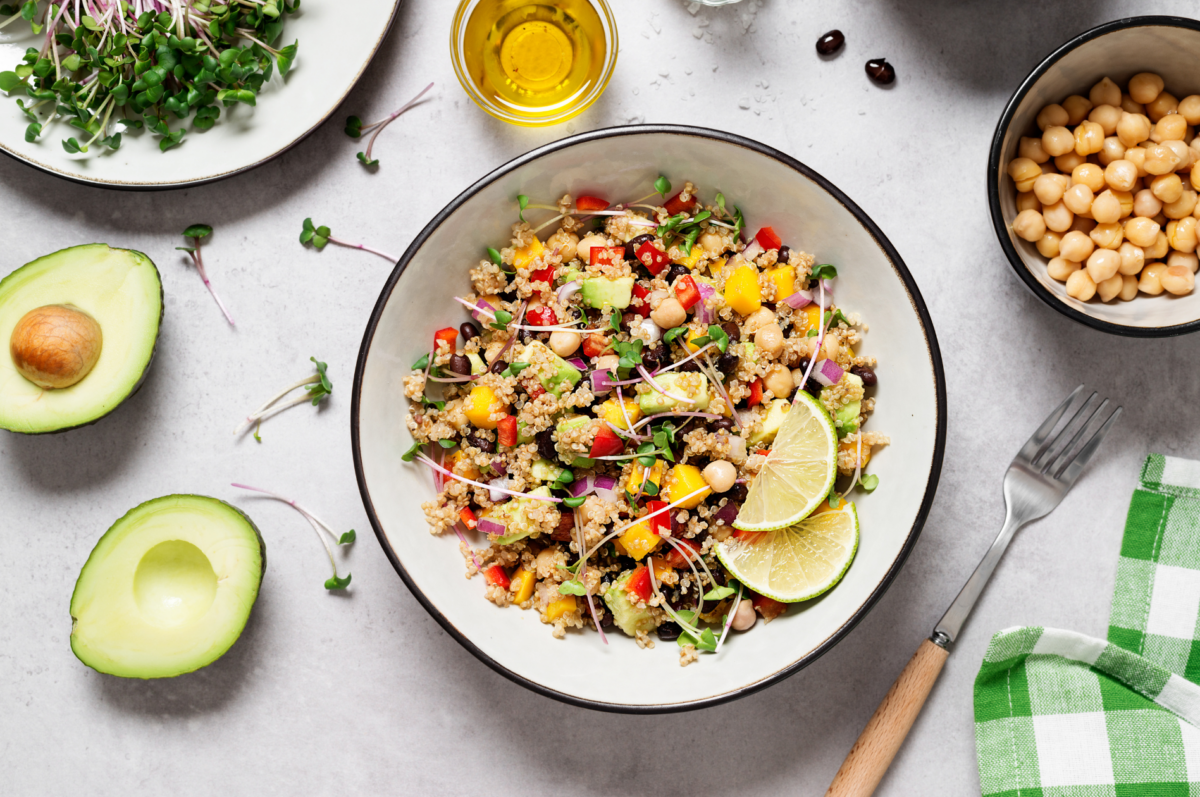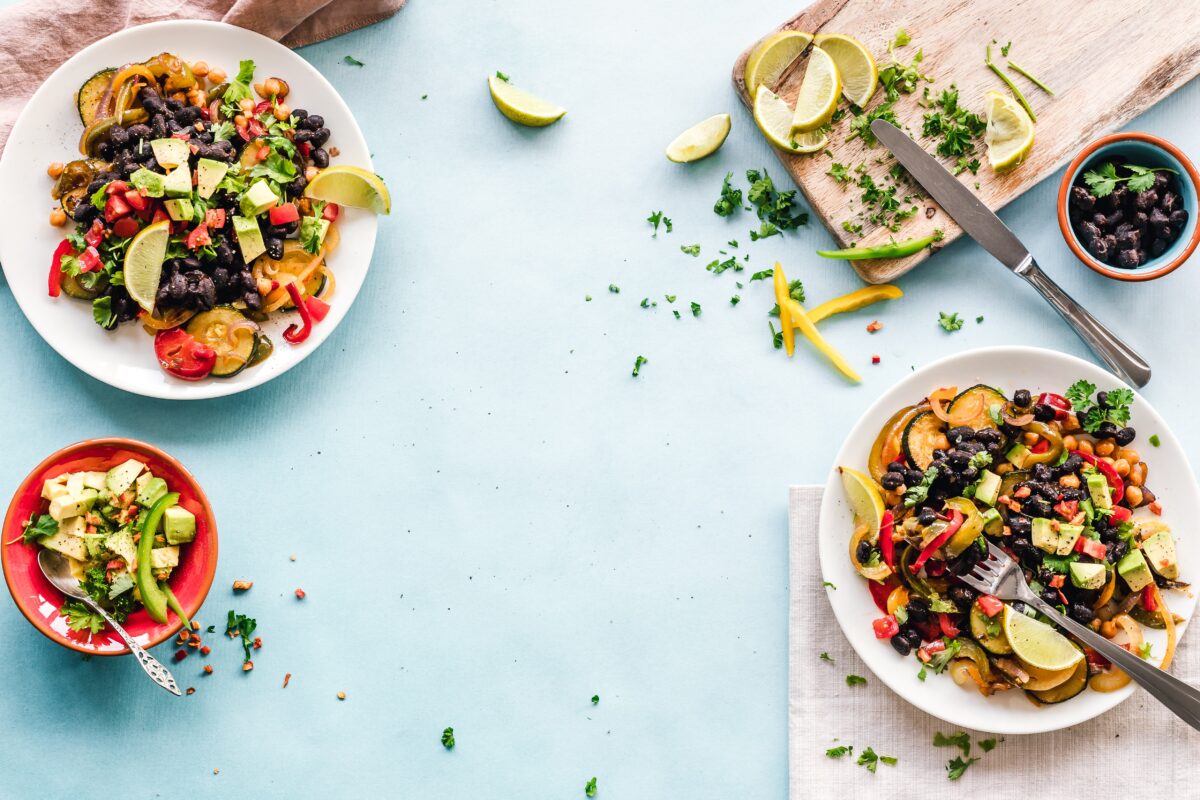The holidays are filled with great-tasting foods, sadly those foods are not always the healthiest. This guide will help you make easy substitutions that will not only make your meals healthier (or at least less unhealthy) but will also enhance flavor and nutrient content.
Macro Distribution
If “healthier” is your focus, you’re going to get the most impact here. Macros are the carbs, fats, and protein in foods that collectively make up the calorie content of foods. The foundational health goal would be to not overdo it on the carbs and avoid pairing high-fat high-carb foods together.
Think of your traditional American Christmas dinner: turkey or ham (protein), dressing (carb), mac and cheese (carbs and fats), sweet potato casserole (carb), fruit salad (more carbs), and dessert (exclusively carbs and fats). The average is 100g or more of carbs and about 50g of fat.
To offset, make substitutions to high-carb/high-fat dishes that will help keep carbs lower:
- Try a cheesy cauliflower dish instead of mac-and-cheese
- Use sugar substitutes in deserts (more on this later)
- Use less sugar in dishes that are already naturally sweet (like sweet potato casserole)
- Or use a natural sweetener instead of granulated sugar like maple syrup or honey.
- Use whole grain/whole wheat instead of white to add more fiber and lessen the glycemic load
Avoid Artificial and Added Ingredients aka “Fake” Foods
There’s a trade-off here – most artificial and added ingredients are going to come from the items that make cooking a little easier for you. Cream of mushroom/chicken soup, for example, is something used in many holiday dishes. But that Campbells can from the grocery store shelf is loaded with all sorts of things that harm your body.
The trade-off is spending the extra time making your own. I know this sounds like a big task and will make some of these meals more time-consuming, but there’s an upside…
You can’t beat homemade!
Sticking to the cream of mushroom example, this is something I do every time I make my green bean casserole. It’s award-winning (at least per the family’s unanimous vote). And it’s all because the sauce is made fresh. You just can’t be the flavor! Your entire family will be impressed.
Quick-and-Easy ingredients to avoid and what to use instead:
- Any sort of canned soup – go the extra mile and make it homemade. Here’s the green bean casserole recipe with the cream of mushroom soup.
- Pre-packaged stuffing mix (loaded with preservatives and sodium) – instead, get yourself some fresh, whole grain bread, use a clean cornbread recipe that’s low in sugar, toast the bread in the oven, add the other ingredients, and you have yourself a tastier and healthier dressing. Here’s a recipe
- Canned cranberry sauce – throw some cranberries in a pan and simmer one low-medium until they’re cooked and thickened. Add flavors of choice like white wine, herbs, honey, or a little arrowroot powder to thicken it as needed.
- Graham crackers for pie crust – use this alternative that’s naturally sweetened instead
Baking Substitutes
Baking sweet treats is a holiday staple. Here are some tips for keeping your carb/sugar intake within a healthier range.
- Use sugar alternatives – Swerve is an excellent brand for sugar-alternative baking sweeteners, they make confectioner, brown, and granulated sugars.
- They’re calorie-free and they use oligosaccharides that feed good microbes in the gut. The downside is that they also use erythritol which is a sugar alcohol – this can cause GI distress. It’s best to use this in smaller amounts (like in frostings) rather than in recipes that call for 2+ cups of sugar (though let’s be honest, as good as they may be, no one needs to be eating anything that has that much sugar in it!).
- Use natural sugars – when you don’t want to overdo it on the sugar alcohols, you can use honey, maple syrup, date syrup, or coconut sugar in place of granulated sugar as a 1:1 replacement.
- While these are natural and potentially better than ultra-processed white sugar, they still have a downside – you’re going to get the same amount of carbs as regular sugar. So use these sparingly.
- Use Natural Sugar Alternatives – The best of both worlds, these are both calorie-free and natural. Most people will not experience the GI distress that sugar alcohols can cause. Stevia and Monk fruit are both from plants and are a great sugar alternative.
- The downside – some people may experience an aftertaste (though not nearly as bad as sucralose or aspartame).
- They also do not convert 1:1 as a sugar replacement – their taste is much sweeter than sugar so you need less. See the conversion chart below from NuNaturals on how to convert measurements.
- Use whole wheat flour instead of white flour – you can find it both all-purpose and regular. whole wheat packs much more fiber which lowers the glycemic load of this starchy ingredient
- For low-carb recipes, use almond flour instead of wheat flour.
- Use coconut oil instead of butter or canola. This works great in vegan recipes and for decadent dishes like brownies. You can replace it in a 1:1 ratio.
Making Dishes Gluten Free
There are many options for substituting gluten. Many of which will add additional protein to the dish and/or fiber. Here are my top picks:
- Use chickpea flour – this is great in dishes that you’ll make a roux for such as soups, or creamy sauces. It has a rich and savory depth of flavor so it pairs well with meats and umami dishes.
- Use oats – Instant oats are a great replacement in dishes that call for bread crumbs. Use oat flour in baking recipes. You can find it in stores or easily make your own. Use a 1:! ratio with flour, add instant oats to a blender, food processor, or coffee grinder, and blend until you get a fine powder or leave it course for texture.
- Use cooked rice or quinoa – great for holding meats together in dishes that require forming such as meat loaves, patties, and balls (you can use oats here too).
- Use Almond flour – while it’s not the best substitute for all-purpose flour for baking, it’s great when used to make pie crusts, sausage balls, or shortbread cookies. Great for making low-carb meals.
Adding Flavor to Meals – The Healthy Way
A dish is not complete without the perfect balance of flavor. Here are some easy tips for boosting flavors and nutrient profiles.
- Salt – Salt is essential to cooking. Use sea salt like Redmond Real Salt or Celtic sea salt to add more minerals to your food.
- But over-salt it – sometimes dishes taste like they need more salt when really all they need is an acid. Use a splash of vinegar, lemon, or lime juice instead of more salt to get the flavor just right.
- Bone Broth – there is a richness to bone broth that adds a depth of flavor to dishes that you just can’t get from regular stock. It’s also loaded with more nutrients and protein than regular stock. Use it in soups, sauces, and roux, or when cooking beans, rice, or other grains instead of water.
- Spices – toss out the Old Bay and store-brand all-purpose seasoning salt and replace it with classic herbs like thyme, basil, oregano, and marjoram. There’s nothing like fresh herbs and spices in dishes. This also adds medicinal properties to foods as many of these foods are also used in supplements (like turmeric and oregano).
- Use fresh garlic – If you do nothing else to enhance the flavor and medicinal properties of meals, replacing preserved garlic or garlic salt with real garlic would be a great start. There’s nothing like the flavor of fresh minced garlic in a dish, and it’s great for the heart, the gut, inflammation, and more.















